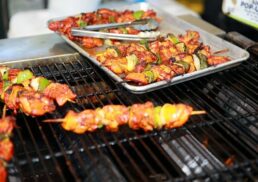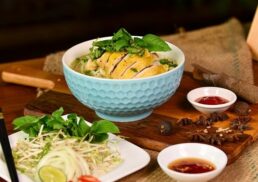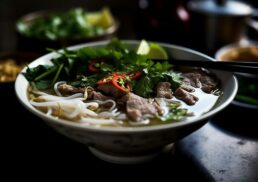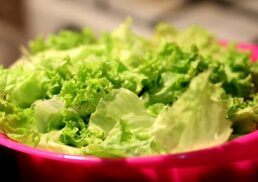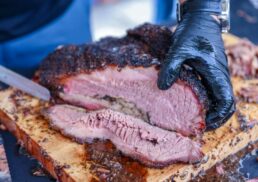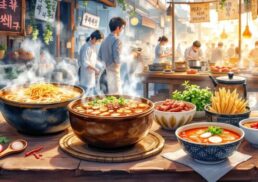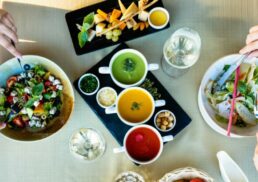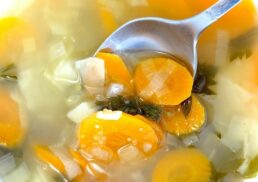Curious about the best noodles in Vietnam? This article dives into ten must-try noodle dishes that showcase the country’s diverse culinary landscape. From the aromatic Pho to the spicy Bun Bo Hue, each dish offers a unique taste experience. Discover the history, ingredients, and flavors that make these noodles a staple in Vietnamese cuisine.
Table of Contents
Key Takeaways
Pho is Vietnam’s national dish known for its aromatic broth and versatility, enjoyed across different regions with unique variations.
Bun Cha, popularized by global figures, features grilled pork meatballs and vermicelli noodles, creating a delicious balance of smoky and fresh flavors.
Each noodle dish, like Mi Quang and Bun Bo Hue, highlights regional flavors and cultural influences, making Vietnam’s noodle cuisine diverse and rich.
Pho: Vietnam’s National Dish
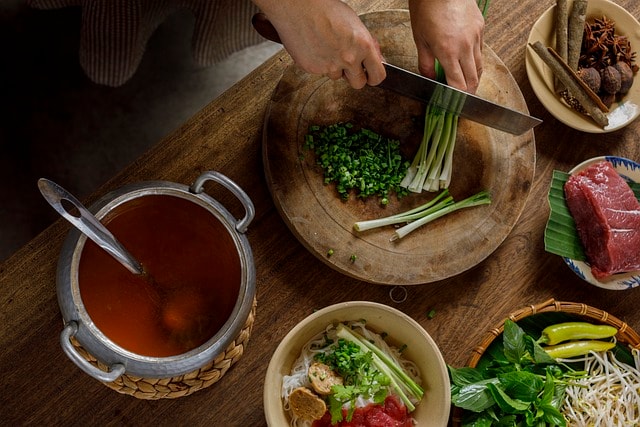
Pho, often considered Vietnam’s national dish, originates from the northern region, specifically Nam Định Province, between 1900 and 1907. This Vietnamese classic consists of flat rice noodles served in a flavorful meat broth, typically made from beef or chicken bones, and simmered with spices such as cinnamon, star anise, and cloves. The aromatic broth is what sets Pho apart, creating a comforting and deeply satisfying dish.
Hanoi, widely regarded as Pho’s birthplace, offers a traditional style of this noodle soup that is less sweet compared to its southern counterpart. The northern version often features fewer herbs, allowing the rich beef broth to shine. On the other hand, the southern style, commonly found in Ho Chi Minh City, is sweeter and accompanied by a generous array of herbs and vegetables, adding fresh and vibrant flavors to the dish.
Pho is enjoyed at any time of day, reflecting its widespread popularity. It’s integral to special occasions like Tet, the Vietnamese New Year. This versatile noodle dish has even gained international fame, introduced to the world by Vietnamese refugees after the Vietnam War. Whether you prefer Pho Bo (beef pho) or Pho Ga (chicken pho), the experience of slurping these delicious noodles is universally cherished.
Every bowl of Pho tells a story of Vietnam’s rich culinary heritage and the meticulous care put into each ingredient. Enjoying this Vietnamese classic means partaking in a century-old tradition that continues to warm hearts and bellies worldwide.
Bun Cha: Grilled Pork Meatballs with Vermicelli Noodles
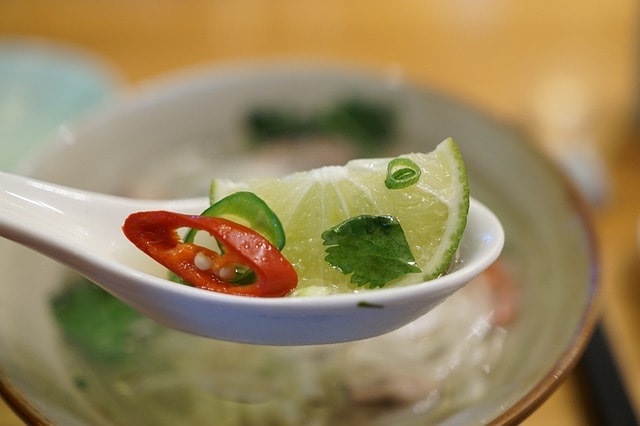
A symbol of Hanoi’s street food culture, Bun Cha gained international fame when President Obama and Anthony Bourdain shared a meal of it in Vietnam. This delightful dish features grilled pork meatballs and pork belly served with vermicelli noodles, fresh herbs, and a tangy vinegar-lime fish sauce broth. The smoky flavor of the grilled pork, achieved by cooking over a charcoal or wood fire, is a highlight of this dish.
The components of Bun Cha offer a harmonious balance of textures and flavors. The light dipping sauce, often infused with chili and garlic, adds a zesty kick, while the crunchy pickled vegetables and fresh herbs like Thai basil and mint provide a refreshing contrast. Each bite delivers an explosion of flavors, leaving a memorable impression on your palate.
Bun Cha on the bustling streets of Hanoi offers a unique experience. The aroma of grilled pork wafts through the air, inviting you to partake in this beloved Vietnamese noodle dish. For both locals and visitors, Bun Cha offers a taste of Hanoi’s vibrant food scene that’s not to be missed.
Mi Quang: Central Vietnam’s Signature Noodle Dish
Originating from the Quang Nam Province, Mi Quang is a signature dish of Central Vietnam that stands out with its vibrant yellowish rice noodles, colored by turmeric. This noodle dish is known for its unique preparation, where the noodles are served with minimal broth, allowing the toppings to take center stage.
Common toppings for Mi Quang include pork belly, chicken, shrimp, boiled eggs, and roasted peanuts, each adding layers of flavor and texture. The dish is often garnished with fresh herbs and crunchy vegetables, creating a delightful contrast with the tender noodles. Influenced by Cantonese and French culinary traditions, Mi Quang is a testament to the cultural fusion that defines Vietnamese cuisine.
The minimal broth, often infused with fish sauce and other seasonings, moistens the noodles without making the dish too soupy. This approach highlights the vibrant toppings and ensures that each bite is packed with flavor.
Mi Quang offers a culinary adventure that is as visually appealing as it is delicious, making it a must-try for any food enthusiast exploring Central Vietnam.
Bun Bo Hue: Spicy Beef Noodle Soup
Bun Bo Hue, hailing from the imperial city of Huế, is renowned for its spicy and aromatic broth, setting it apart from other Vietnamese noodle soups. The broth’s rich flavor is achieved through the use of lemongrass and spicy chili oil, creating a complex and satisfying taste. This noodle dish features round rice noodles, beef, and pork cuts, including unique ingredients like congealed pork blood.
The preparation of Bun Bo Hue involves simmering beef bones and pork hocks to create a deeply flavorful meat broth. This broth is then seasoned with shrimp paste, fish sauce, and sugar, resulting in a harmonious blend of savory and spicy flavors. The dish is often garnished with fresh mint leaves and homemade chili paste, adding an extra layer of heat and freshness.
Although less popular in American cuisine compared to Pho, Bun Bo Hue offers a bold and spicy alternative that is sure to excite your taste buds. The spicy broth, tender meat, and chewy round rice noodles make this dish a favorite among those who enjoy robust flavors and a bit of heat.
Cao Lau: Hoi An’s Unique Noodle Dish
Cao Lau, the most famous noodle dish from Hoi An, boasts a unique texture and flavor, making it stand out among other Vietnamese noodle dishes. The noodles are made from rice that is neither freshly harvested nor too aged, soaked in water from the Ba Le well, and mixed with a lye solution derived from the ashes of specific trees, particularly the ‘tro’ tree from Cham Island. This meticulous preparation gives the noodles their distinctive chewiness.
Topped with marinated and roasted pork loin or trotter, fried pork skin, and a small amount of broth, Cao Lau offers a delightful combination of textures and flavors. The broth, typically made from pork bones, is poured over the noodles to wet them but not to the point of being soupy, allowing the individual components to shine.
Fresh herbs, lime juice, and chili paste often garnish the dish, adding bursts of freshness and heat to each bite. Cao Lau reflects the rich history and cultural influences of Hoi An, making it a must-try for anyone visiting this charming town.
Bun Thit Nuong: Grilled Pork with Vermicelli Noodles
Bun Thit Nuong combines the savory goodness of grilled pork with the freshness of vermicelli noodles and herbs, creating a dish that is both comforting and refreshing. The pork is marinated with a blend of lemongrass, garlic, lime, fish sauce, soy sauce, and sugar, resulting in a flavorful and aromatic meat that pairs perfectly with the noodles.
The dish is assembled by layering rice vermicelli noodles with lettuce, pickled vegetables, and grilled pork, all topped with fresh herbs like mint and Thai basil. A generous drizzle of nuoc cham sauce, made from chili, garlic, lime, and fish sauce, ties everything together, adding a tangy and spicy kick. This combination of flavors and textures makes Bun Thit Nuong a delightful and satisfying meal.
Bun Thit Nuong’s customizable nature is one of its joys. Diners can assemble their own bowls, adjusting the amount of sauce and toppings to suit their personal preferences. This interactive aspect, along with the dish’s vibrant flavors, makes Bun Thit Nuong a popular choice for both locals and visitors alike.
Hu Tieu: Versatile Southern Vietnamese Noodle Soup
Hu Tieu is a versatile noodle soup that showcases the rich culinary traditions of Southern Vietnam.
The broth, made from:
pork bones
dried squid
rock sugar
vegetables
is both sweet and savory, creating a comforting and flavorful base for the dish.
The name ‘Nam Vang’ links Hu Tieu to its historical context, as it refers to Phnom Penh, highlighting the dish’s Cambodian influences.
This noodle soup can be served with a variety of toppings, including minced pork, seafood, meatballs, and shrimp. The noodles themselves can vary, with options such as round rice noodles, flat rice noodles, and even egg noodles, each adding a different texture to the dish. Fresh herbs and garnishes like blanched bean sprouts and chrysanthemum greens add a burst of freshness and color.
Hu Tieu’s versatility extends to its serving times, as it can be enjoyed for both breakfast and dinner, making it a staple in many Vietnamese households. Hu Tieu offers a comforting and satisfying meal, perfect for any time of day, whether you’re dining at a street vendor or an upscale restaurant.
Banh Canh: Thick Noodle Soup
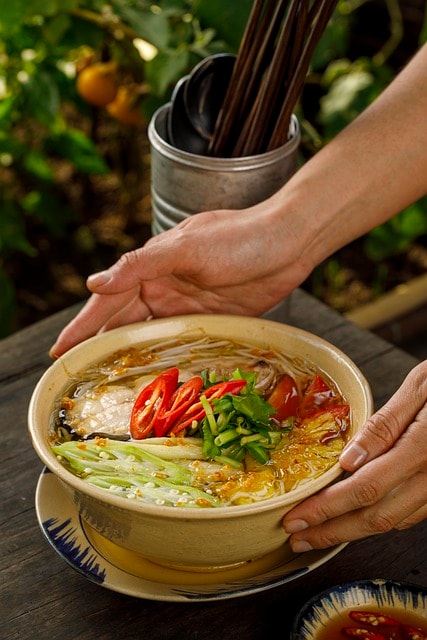
Banh Canh features thick and chewy Vietnamese noodles that set it apart from other Vietnamese noodle soups. These noodles, made from tapioca or rice flour, are rolled by hand and cut into long strands, giving them a unique texture. The broth of Banh Canh has a gravy-like consistency, often enriched with pork trotters, snakehead fish, or crab, creating a rich and satisfying dish.
This thick noodle soup is commonly found at street corners in Ho Chi Minh City, where it is enjoyed by locals and visitors alike. Thick noodles and a hearty broth make Banh Canh a comforting choice, especially on cooler days. Its distinctive texture and flavor profile make it a standout among Vietnamese noodle dishes.
Check out Thick Noodle Soup (Bánh Canh).
Bun Rieu: Crab Noodle Soup
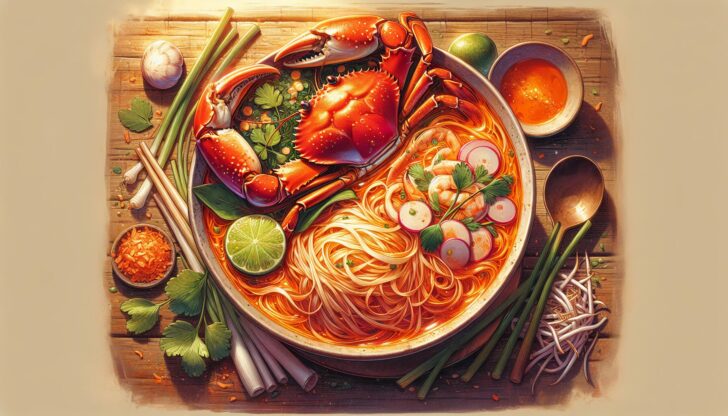
Bun Rieu is a vibrant and flavorful noodle soup that features a crimson broth made from tomato paste and annatto oil. The main type of meat used in this dish is freshwater paddy crab, which adds a delicate and sweet flavor to the soup. The broth is further enhanced with rice vinegar, giving it a distinct sourness that balances the sweetness of the crab.
Before:
Common toppings for Bun Rieu include beef, pork, Vietnamese sausages, and fresh herbs such as kinh gioi and mint, adding layers of flavor and texture to the dish. These ingredients create a complex and satisfying noodle soup that is both refreshing and hearty.
After:
Common toppings for Bun Rieu include:
Beef
Pork
Vietnamese sausages
Fresh herbs such as kinh gioi and mint
These ingredients create a complex and satisfying noodle soup that is both refreshing and hearty.
Bun Rieu offers a unique culinary experience that is sure to delight any noodle lover.
Bun Mam: Fermented Fish Noodle Soup
Bun Mam, known for its distinctive and bold flavors, features a broth made primarily from fermented fish sauce. This unique ingredient gives the soup a rich and savory taste that is unlike any other Vietnamese noodle dish. The preparation of the broth involves boiling fish sauce to separate the flesh and straining it to obtain a clear and flavorful liquid.
Traditional toppings for Bun Mam include Chinese crackling pork and cooked prawns, adding a delightful contrast of textures. The dish’s origins can be traced back to Cambodia, where it was originally made with prahok, a fermented fish paste.
Bun Mam, often enjoyed during cooler months, provides warmth and comfort with each spoonful. This nutrient-rich dish is perfect for those looking for a hearty and flavorful meal.
Summary
From the iconic Pho to the bold flavors of Bun Mam, Vietnamese noodle dishes offer a diverse and rich culinary experience that reflects the country’s history and culture. Each dish carries its own unique story, ingredients, and preparation methods, showcasing the creativity and skill of Vietnamese cuisine.
We hope this journey through Vietnam’s top 10 must-try noodle dishes has inspired you to explore these flavors, whether by visiting Vietnam or trying your hand at making them at home. The world of Vietnamese noodles is vast and delightful, promising unforgettable tastes and memories. So go ahead, indulge in these culinary treasures and experience the magic of Vietnam, one bowl at a time.
Frequently Asked Questions
What makes Pho different from other Vietnamese noodle soups?
Pho stands out because of its flavorful broth, simmered with spices like cinnamon and star anise, along with its unique flat rice noodles. Whether you choose beef or chicken, it offers a comforting and aromatic experience like no other Vietnamese noodle soup.
Where can I try Bun Cha in Hanoi?
You can try Bun Cha at numerous street food stalls and local eateries across Hanoi. It’s a must-try dish that really captures the city’s culinary charm!
What is the most unique aspect of Mi Quang?
The most unique aspect of Mi Quang is its vibrant turmeric-colored noodles paired with minimal broth, letting the delicious toppings like pork belly and shrimp shine. It creates a delightful mix of flavors and textures that you won’t forget!
How spicy is Bun Bo Hue compared to other noodle soups?
Bun Bo Hue is definitely spicier than many other noodle soups, thanks to its rich broth infused with lemongrass and chili oil. If you enjoy a good kick in your soup, this one’s a delicious choice!
Can I find these noodle dishes outside of Vietnam?
Absolutely, you can find Vietnamese noodle dishes at Vietnamese restaurants worldwide, as they’ve become quite popular thanks to the vibrant global culinary scene. Enjoy exploring these tasty flavors no matter where you are!
